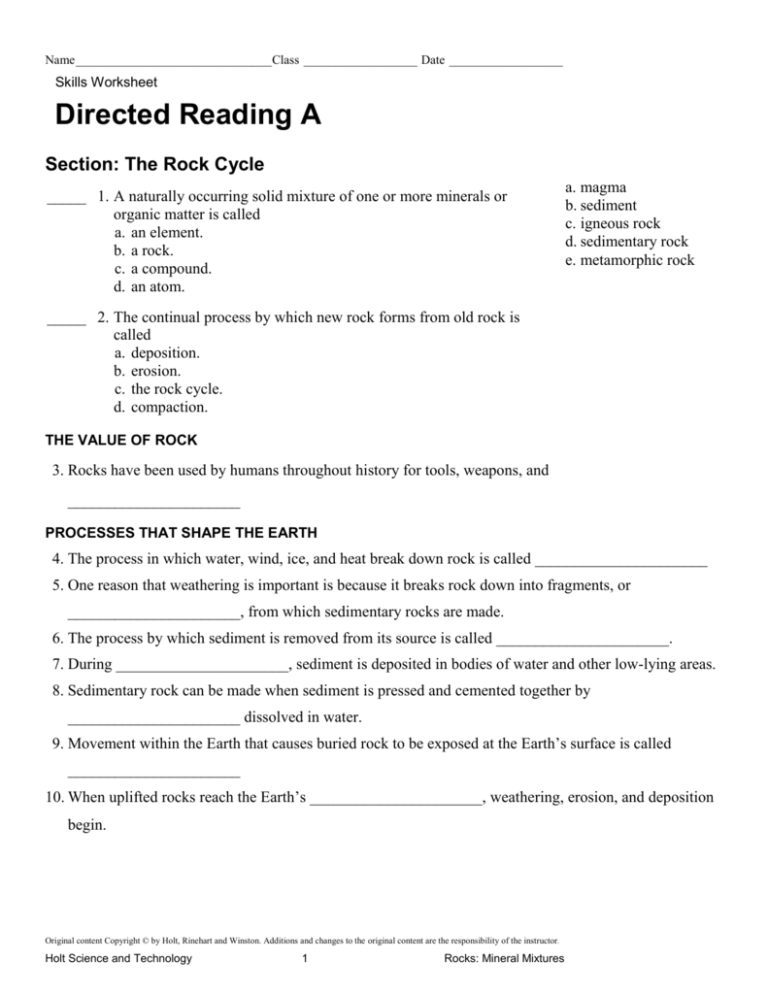1 Directed Reading A - Lincoln Park Public Schools
advertisement

Name _______________________________Class __________________ Date __________________ Skills Worksheet Directed Reading A Section: The Rock Cycle _____ 1. A naturally occurring solid mixture of one or more minerals or organic matter is called a. an element. b. a rock. c. a compound. d. an atom. a. magma b. sediment c. igneous rock d. sedimentary rock e. metamorphic rock _____ 2. The continual process by which new rock forms from old rock is called a. deposition. b. erosion. c. the rock cycle. d. compaction. THE VALUE OF ROCK 3. Rocks have been used by humans throughout history for tools, weapons, and ______________________ PROCESSES THAT SHAPE THE EARTH 4. The process in which water, wind, ice, and heat break down rock is called ______________________ 5. One reason that weathering is important is because it breaks rock down into fragments, or ______________________, from which sedimentary rocks are made. 6. The process by which sediment is removed from its source is called ______________________. 7. During ______________________, sediment is deposited in bodies of water and other low-lying areas. 8. Sedimentary rock can be made when sediment is pressed and cemented together by ______________________ dissolved in water. 9. Movement within the Earth that causes buried rock to be exposed at the Earth’s surface is called ______________________ 10. When uplifted rocks reach the Earth’s ______________________, weathering, erosion, and deposition begin. Original content Copyright © by Holt, Rinehart and Winston. Additions and changes to the original content are the responsibility of the instructor. Holt Science and Technology 1 Rocks: Mineral Mixtures Name _______________________________Class __________________ Date __________________ Directed Reading A continued ILLUSTRATING THE ROCK CYCLE Match the correct description with the correct term. Write the letter in the space provided. _____ 11. magma in the Earth’s crust that has risen to the surface and cools and solidifies _____ 12. rock that is forced downward and is altered due to heat and pressure _____ 13. rocks that are partially or completely melted _____ 14. igneous rock at the Earth’s surface that is weathered and wears away _____ 15. sediment that washes down into rivers and oceans and is pressed and cemented together ROUND AND ROUND IT GOES _____ 16. A rock at the Earth’s surface is primarily affected by forces of a. heat and pressure. b. pressure only. c. weathering and erosion. d. cooling. _____ 17. A rock deep underground is primarily affected by forces of a. extreme heat and pressure. b. cooling. c. weathering and erosion. d. heat only. ROCK CLASSIFICATION _____ 18. Scientists study rocks using what important criteria? a. composition and texture b. the depth at which they formed c. elevation d. the pressure under which they formed _____ 19. What is the chemical makeup, or mineral content, of a rock based on? a. the size of its grains b. the positions of its grains c. the shape of its grains d. its composition Original content Copyright © by Holt, Rinehart and Winston. Additions and changes to the original content are the responsibility of the instructor. Holt Science and Technology 2 Rocks: Mineral Mixtures Name _______________________________Class __________________ Date __________________ Directed Reading A continued _____ 20. A rock that consists mostly of the mineral quartz will have a composition very similar to a. basalt. b. siltstone. c. quartz. d. limestone. _____ 21. What do the size, shape, and positions of the grains that make up a rock determine? a. the rock’s texture b. the rock’s size c. the rock’s color d. the rock’s composition _____ 22. What factors can affect the texture of a sedimentary rock? a. the length of time the magma had to cool b. the temperature the rock was exposed to c. the color of the rock d. the size of the grains that make up the rock _____ 23. What factors can affect the texture of an igneous rock? a. the length of time the magma had to cool b. the size of the rock c. the minerals that cement the rock together d. the pressure and temperature the rock was exposed to Original content Copyright © by Holt, Rinehart and Winston. Additions and changes to the original content are the responsibility of the instructor. Holt Science and Technology 3 Rocks: Mineral Mixtures Name _______________________________Class __________________ Date __________________ There are three basic kinds of rocks: igneous, sedimentary, and metamorphic rocks. Igneous Rocks: Igneous rocks are formed when lava or magma cools down and becomes a solid. Sedimentary Rocks: Sedimentary rocks are formed when existing rock is eroded and deposited in sediments. The sediments accumulate until they are formed into new rock under pressure, heat, and chemical bonding. Metamorphic Rocks: Metamorphic rocks are formed when existing rocks are put under heat, pressure, or both. The heat and pressure causes the minerals to change their structure so that new rocks are formed. igneous metamorphic sedimentary basalt anthracite chert gabbro gneiss conglomerate obsidian marble gypsum pumice schist limestone rhyolite slate sandstone soapstone shale quartzite Original content Copyright © by Holt, Rinehart and Winston. Additions and changes to the original content are the responsibility of the instructor. Holt Science and Technology 4 Rocks: Mineral Mixtures






